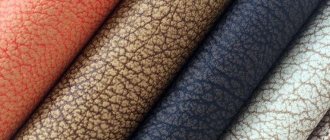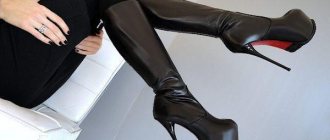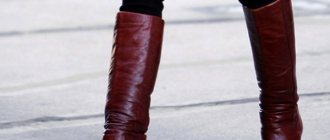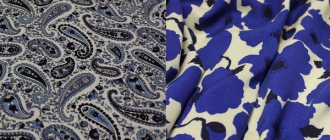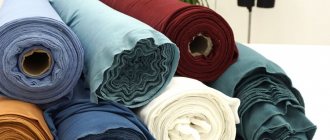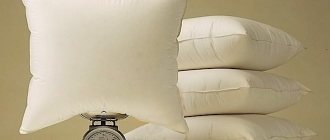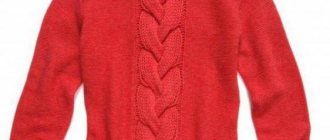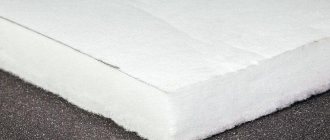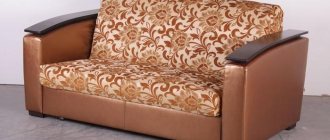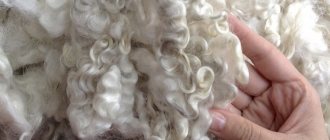Properties of artificial leather
Artificial leather is a safe, durable and reliable material. It is actively used for the production of shoes, accessories, interior items, furniture, clothing and much more. For the production of leatherette, fabric and non-woven bases are used, on which a special polymer layer is applied. Today, myths about the low quality of leather substitutes are long gone. Advanced production technologies make it possible to create wear-resistant and durable materials that cope well with temperatures and aggressive agents. This is a very important quality when it comes to shoe leather.
Basic properties of leatherette
The properties of leather made from polymer materials vary depending on the technology of its production. Modern developments have made it possible to create materials that are resistant to frost and even fire.
General properties of artificial leather:
- hypoallergenic. Leatherette is completely safe for the human body. It does not emit substances that can cause allergies;
- permeability. Modern artificial leather does not cause a greenhouse effect. The latest technologies have made it possible to make it “breathable”. Thanks to this, the material maintains a constant temperature. It does not overheat in the sun and does not harden in cold weather;
- softness. Artificial materials are very pleasant to the touch. They are distinguished by softness and tenderness;
- wear resistance. Leatherette can last for more than one year. If previously leatherette clothes had to be thrown away after a season, now they last for decades;
- nice smell. Innovative manufacturing techniques have eliminated the unpleasant odor from leatherette.
When choosing artificial leather, you also need to pay attention to such a property as density. It differs for different leatherette samples. This indicator determines the strength and scope of use of leatherette.
§ 4. Assortment and quality characteristics of artificial leather on fabric and non-woven basis
Artificial leathers on fabric and non-woven basis are divided according to their purpose in footwear production into the following main groups:
- artificial leather for external parts of shoe uppers;
- artificial leather for internal (lining) parts of shoe uppers;
- artificial leather for heels and toes of shoes;
- artificial leather for shoe welts.
Artificial leather on fabric and non-woven basis for external parts of shoe uppers
Artificial leathers on a fabric and non-woven basis for the external parts of shoe uppers find a variety of, although limited, applications in shoe production. They are used for the tops of yuft and chrome boots, for parts of the uppers of summer open shoes, as well as boots. For the external parts of the shoe upper, shoe tarpaulin, shargolin, textvinite, artificial suede, artificial varnish, vlakalim and sovinol, artificial leather on a non-woven base (IC), etc. are used.
Shoe tarpaulin and shargolin. Shoe tarpaulin and shargolin, as previously indicated, are dyed cotton fabric of complex weave - three-layer tarpaulin, impregnated and covered with a vulcanized rubber mixture or coated with polyvinyl chloride plastic compound and suitably finished on the front side. Shoe tarpaulin and shargolin are made in black, with a coarse-grained cut on the front surface (“shagreen”). Shoe tarpaulin and shargolin are used for the tops of yuft boots, as well as for the upper parts of certain types of industrial shoes. Indicators of physical and mechanical properties of shoe tarpaulin and shargolin, provided for by GOST, are given in table. 17.
Table 17. Physical and mechanical properties of shoe tarpaulin and shargolin
In terms of performance properties, boot tops made of shoe tarpaulin and shargolin are inferior to leather ones. The wear of tops made of shoe tarpaulin and shargolin, as well as from other artificial leathers, when wearing boots is initially expressed in the appearance of abrasions of the front covering on the folds of the tops and near the neck of the front. With further wear, through wear forms, mainly on the folds of the tops on the inside, as a result of mutual friction of the tops against each other when walking. The faster wear of tops made of shoe tarpaulin and shargolin compared to the wear of leather tops is explained by the formation of large, rough folds that protrude strongly and are difficult to penetrate. The average service life of boot tops made of shoe tarpaulin and shargolin is usually 7-8 months.
Kirgolin
— artificial leather on a fabric base (velveton) with a rubber (based on synthetic rubber) vulcanized coating and front finishing with synthetic polymers.
Kirgolin is characterized by a thickness in the range of 0.9-1.1 mm
, a load at break of strips of
20×100 mm
- no less than
400 N
on the warp and
360 N
on the weft, elongation at break of at least 8% on the warp and 20% on the weft, abrasion resistance per 1000 revolutions - no more than
300 mg
, hardness within
25-50 G
, vapor permeability - no less than
0.8 mg/cm2*h
, frost resistance (under static conditions) - no higher than -40° C. Due to the relatively high resistance To prevent abrasion, Kirgolin is used for the tops of chrome boots instead of the previously used fleece.
Shoe textile.
Shoe textile, which is a cotton fabric coated with polyvinyl chloride, is produced in a wide range of colors, with the front surface embossed to match the natural grain of the leather. Porous shoe textile is made on shoe fabric, non-porous - on calico and calico for finishing shoes and on AST-28 fabric - for parts of shoe uppers.
Textovinite has a leather-like appearance and is soft and flexible. The front coating of textvinite is resistant to abrasion under operating conditions and is well bonded to the underlying tissue. Porous textvinite is superior in air and vapor permeability to a number of other types of artificial soft leather. Physical and mechanical properties of textvinite (thickness, weight 1 m2
, breaking load, elongation at break, etc.) depend mainly on the type of fabric used as a base.
Shoe textinite has many uses. It is used for the manufacture of the tops of chrome boots, the uppers of summer open and indoor shoes, for finishing shoes with textile uppers, i.e. for parts and types of shoes for which the requirements for the molding and performance properties of the upper materials are somewhat reduced.
Requirements for the quality of shoe textinite, imposed by technical specifications, are given in table. 18.
Table 18. Physical and mechanical properties of artificial leather for shoe uppers
Sovinol and vlakalim.
Sovinol is an artificial leather based on AST-28 fabric with a one-sided coating of polyvinyl chloride resin with appropriate ingredients (plasticizers that increase frost resistance, etc.), combined with divinyl nitrile rubber SKN-26. Vlakalim differs from sovinol by the presence in the front covering of a porous layer of foamed polyvinyl chloride, which makes the material more soft and leather-like and increases its resistance to repeated bending.
Sovinol and vlakalim are close in appearance to natural leather. They have high abrasion resistance, exceeding the abrasion resistance of other types of artificial leather, low elongation at break (especially along the base), and provide the necessary strength for thread fastenings. At the same time, sovinol and vlakalim are characterized by low resistance to repeated bending, insufficient frost resistance, allowing shoes with uppers made of these materials to be worn at temperatures not lower than -15 ° C, and very low vapor permeability, almost equal to zero.
The peculiarities of sovinol and vlakalim, as well as other types of artificial leather for shoe uppers, are low molding properties and insufficient preservation by parts of these materials of the sizes and shapes given to the blanks on the lasts during the molding process. To improve the conditions for molding shoe uppers from sovinol and vlakalim, volumetric blanks are used or the blank made from these materials is supplemented with a leather binding along the lower perimeter. In order to eliminate shrinkage of artificial leather upper parts after removing shoes from lasts, molding in some cases is completed by short-term heat treatment at a temperature of 70-100 ° C.
Sovinol and vlakalim are used mainly for the manufacture of winter boots with insulated lining, intended for wear in moderate cold conditions. The high ability of the insulated lining to absorb moisture when wearing shoes in winter conditions to a certain extent compensates for the vapor permeability of the shoe upper material.
Faux patent leather.
Artificial (polyvinyl chloride) patent leather in its basic properties is close to non-porous textinite. The main features of artificial (polyvinyl chloride) patent leather are a smooth, without embossing, mirror-shiny front surface and a slightly thicker coating (to mask the texture of the fabric base). It is used for parts of the uppers of open shoes and boots.
A type of artificial patent leather is varnish with rubber or polyvinyl chloride coatings, covered on the front side with a film of polyester urethane resin. Additional application of a front film of polyester urethane resin leads to a significant improvement in the performance properties of artificial patent leather.
Artificial (bulk, electrostatic) suede.
Faux suede is a cotton fabric coated with polyvinyl chloride, over which viscose staple fibers are glued. For the manufacture of artificial shoe suede, mainly AST-28 fabric is used; its use as a fabric base provides the best mechanical properties of artificial suede.
Artificial suede is produced in rolls no less than 25 m
.
From the indicators of the physical and mechanical properties of the specifications for artificial suede, thickness, weight of 1 m2
, breaking load and elongation at break along the warp and weft, rigidity (durability), and abrasion resistance of the pile are standardized.
Artificial suede is used in the manufacture of indoor shoes. The disadvantages of this material in many cases are the rapid exposure of the fabric during shoe wear due to abrasion and shedding of the pile, as well as the low strength of adhesion of the fleecy surface of the suede to the sole.
Artificial leather on a non-woven basis (IC).
Initially, IR artificial leather for shoe uppers was produced on a non-woven, unstitched base in plates by hot pressing layers of cotton comb lined with films of polyvinyl chloride plastic compound.
Currently, IK artificial leather for shoe uppers is produced on a non-woven stitched base exclusively in the form of rolls.
Rolled artificial leather IR for shoe uppers on a non-woven stitched base is produced in two types: for the upper of summer women's shoes with a thickness of 0.9-1.0 mm
and for the top of men's sandals with a thickness of
1.5-1.6 mm.
IK artificial leather has various colors, various patterns and different embossing depths.
The physical and mechanical properties of rolled artificial leather IR are characterized by the following indicators: thickness - 1.1±0.15 and 1.4±0.15 mm;
tensile strength and elongation at break (in longitudinal and transverse directions) - not less than
11 n/mm2
and 20%;
resistance to thread breakthrough and tearing (in the longitudinal and transverse directions) of at least 50 and 40 n/mm
;
rigidity (in longitudinal and transverse directions) no more than 1.25 n
.
IK artificial leather for shoe uppers, due to its good appearance and satisfactory performance properties at low cost, is widely used in the manufacture of various types of summer shoes.
Artificial leather on a fabric and non-woven basis for internal (lining) parts of shoe uppers
The range of artificial leathers for lining parts of shoe uppers is limited to shoe artificial futor and artificial polyamide lining leather IR-PA.
Shoe artificial futor.
Shoe artificial futor, which is a cotton fabric impregnated with a vulcanized rubber mixture, has a smooth suede-like surface of light green or light pink color, similar in appearance to lining leather, trimmed on the melon side.
The physical and mechanical properties of the lining are characterized by the following indicators: weight 1 m2
— within
525-625 g
;
thickness - within 0.60-0.95 mm
;
the breaking load of strips 20X100 mm
is not less than
240 N
on the warp and not less than
220 N
on the weft;
elongation at break of not less than 10% for the warp and not more than 35% for the weft; abrasion resistance with a load of 700 g
until through abrasion - at least
3 minutes
;
air permeability - no less than 0.2 cm3/cm2*sec.
In terms of technological and operational properties, artificial footwear is significantly inferior to lining leather. An important negative technological feature of artificial futur is the frayability of the edges. This circumstance prevents the use of futor for lining the heel part with the upper edges trimmed, as is mostly customary in the manufacture of low shoes and shoes. Therefore, artificial futor is used for lining the heel part only for shoes made with the upper edges of the ankle boots being turned inside out, which is associated with the complication of the assembly process of the blanks. Due to the roughness and structure of the fabric and the properties of the impregnating substances, artificial foot wears out relatively quickly during shoe wear; The average service life of the futor heel lining in low shoes and shoes does not exceed 4 months.
Artificial footing is used to line the heel of cheaper types of shoes - textile, combined, indoor. In children's, small children's and husarik shoes, parts made of artificial futur, as well as other types of artificial leather on a fabric and non-woven basis, are not allowed.
Artificial polyamide lining leather IR-PA.
Artificial polyamide leather IR-PA, which is a rolled non-woven stitched base with impregnation and a front coating based on polyamide resins, is significantly different in technological and operational properties from artificial footwear. The cut of polyamide lining leather does not fray, so it can be used for lining the heel of low shoes and shoes that are processed for trimming. The lining made of polyamide artificial leather adheres well to the hard back and has satisfactory molding properties. In terms of hygienic properties (vapor permeability, wetness), IR-PA lining leather is superior to artificial futor, approaching in these properties those of natural lining leather. In terms of abrasion resistance and service life in shoes, polyamide artificial leather lining is also close to lining leather.
The disadvantages of IR-PA artificial leather lining include poor forming properties leading to the formation of folds, high and uneven rigidity, and incomplete coverage of the texture of the non-woven porous base.
In order to eliminate these shortcomings, work is being carried out on the use of combined impregnation with an alcohol-water solution of polyamides and synthetic latexes, as well as on the development of a new lining material - elanite based on coatings of polyvinyl chloride and carboxylate and nitrile rubbers.
The normalized physical and mechanical properties of lining polyamide artificial leather IR-PA are characterized by the following indicators: thickness in the range of 0.70-0.90 mm;
the breaking load of strips
20×100 mm
is not less than
200 N
in the longitudinal direction and
110 N
in the transverse direction;
elongation at break no more than 50% in the longitudinal direction and 90% in the transverse direction; abrasion - no more than 200 g/kW*h;
vapor permeability - not less than
3.0 mg/cm2*h
;
thread breakthrough resistance - at least 50 n/mm
;
rigidity (durability) - 8-20 G
in the longitudinal direction and
8-15 G
in the transverse direction.
Artificial polyamide lining leather IR-PA is used for lining the heel part of combined and textile low shoes and shoes, rear internal belts, shrouds and pads in certain types of shoes, as well as for half-insoles and heel pads.
Artificial leather on fabric and non-woven basis for heels and toes of shoes
Artificial materials for backs and toes can only be classified as artificial leather conditionally, since these materials are completely different from natural leather in appearance and basic properties.
The range of artificial materials for backdrops and toes on a fabric and non-woven basis is very diverse. Paper-based materials for toe caps and paste-like preparations applied directly to the upper or lining parts (from the inside) or to the interlining parts and hardening during subsequent shoe processing are also known to be used in the foreign shoe industry. In the footwear industry of the USSR, granitol, moforin, thermoplastic and other materials on a non-woven basis are used.
Shoe granite.
The use of granitol for backdrops and toes is based on the ability of this material to soften and acquire stickiness after short-term treatment with organic solvents. Granite heels and toe caps, being inserted into blanks before molding, after removing the solvents, acquire the required shape, while simultaneously gluing to the upper and lining of the shoes.
Shoe granite is divided according to two main characteristics: by the type of fabric used to make granite, and by purpose for multi-layer and single-layer parts.
Depending on the type of fabric and purpose, the following grades of granite are distinguished: GMTOG - for multi-layer parts on special fabric; GMBK1 - for multi-layer parts on coated paper-cord; GMTB - for multi-layer parts on a severe low-shrinkage bead; GOKB and GOKB1 - for single-layer parts on coated paper-cord. For single-layer parts (toe caps), granitol is produced with a significantly greater amount of film-forming substances than for multi-layer parts (backdrops and toe caps).
The quality of shoe granite is characterized by a large number of indicators. According to GOST, shoe granite must meet the following requirements: the width, depending on the type of fabric, must be in the range of 77-116 cm
with a tolerance of deviations from ±2.5 to
±4 cm
;
thickness depending on the type of fabric - in the range of 0.7-1.2 mm
with a tolerance of deviations from ±0.1 to
±0.2 mm;
the amount of film-forming substances is not less than
210 g/m2
in granitol for multi-layer parts of the GMTOG, GMBK1 and GMTB brands, not less than 360 and
500 g/m2
in granitol for single-layer parts of the GOKB and GOKB1 brands;
content of volatile substances (moisture and residual solvent) - no more than 8% in granitol for multi-layer parts and 10% in granitol for single-layer parts; softening time in a solvent of standard composition ( 75 parts by volume of
ethyl alcohol,
20 parts by volume of
ethyl acetate and
5 parts by volume of
normal butyl acetate) of granitol for multi-layer parts - no more than 45 seconds, granitol for single-layer parts of the GOKB and GOKB1 brands - respectively no more than 90 and
100 seconds
;
drying time after softening in a standard solvent is no more than 60 minutes
at a drying temperature of 70 ° C;
flash point - not less than 160° C; ash content - no more than 14 and 16% in granitol for single-layer parts of the GOKB and GOKB1 brands and 12% in granitol for multi-layer parts; time for maintaining adhesiveness (more precisely, the duration of setting when gluing granite to fabric) is within 20-30 minutes
.
Granitol can be produced with or without perforation. In grade I granitol, folds, cuts, film peeling, and white spots are not allowed; in grade II granitol, the listed defects should not occupy more than 6% of the total area of the piece.
If the operations of softening and gluing granite heels and toe caps are carried out correctly and the established technological standards are observed for performing the operations of molding blanks on lasts and drying tightened shoes, granite heels and toe caps have the necessary rigidity, elasticity, resistance to repeated mechanical stress when wearing shoes in dry and wet conditions and mostly withstand long service life. The negative aspects of granite toe caps, especially heel pads, include low hygienic properties and severe abrasion of socks and stockings when using shoes after wiping through the lining in the toe and heel parts.
The use of granite in the production of shoes is associated with significant inconveniences: the operations of cutting and assembling granite heels and toes are very labor intensive; they must be softened in toxic, flammable and expensive solvents; when molding blanks with glued granite backs and toes, cases of discoloration of the uppers of leather shoes with nitrocellulose and acrylic coatings are observed; Long-term drying of tightened shoes is required to remove organic solvents introduced into the heels and toes. As a result, granite backdrops are being replaced by more technologically convenient and cheaper leather cardboard backdrops or thermoplastic backdrops, and granite toe caps are being replaced by moforin toe caps, thermoplastic toe caps or toe pads made of flexible elastic materials (such as fabric coated with latex or rolled non-fabric material).
Moforin.
Unlike granite parts, moforin toe caps are softened not in organic solvents, but in a 5% aqueous solution of ammonium chloride. After the mophorin toe caps soften and become sticky, they are glued into the blanks in the same way as granite toe caps. During the subsequent drying of tightened shoes under the influence of heat (at a temperature of 45-50 ° C and above) and an acidic environment caused by the introduction of ammonium chloride into the solution to soften the mophorin toe caps, the process of hardening of the urea-formaldehyde resin occurs and its transition to a water-insoluble state.
The use of moforin compared to shoe granite is associated with a number of advantages: the consumption of expensive and flammable nitrocellulose film-forming and organic solvents is eliminated; production conditions become less harmful; the integrity of the coatings of workpiece parts made of chrome leather with nitrocellulose and acrylic topcoat dyeing is maintained; cases of producing shoes with soft toes and lining lag are almost completely eliminated (due to the greater ease of softening mophorin toe caps and the softened toe caps maintaining the necessary adhesiveness for a long time).
Technological disadvantages of moforin are: increased hygroscopicity and adhesion of individual layers, noticeably expressed aging, as well as the smell of formaldehyde. In order to eliminate sticking during packaging, storage and transportation, mophorin rolls are packed in dense reclaimed casings, and in the summer, when winding into rolls, additionally oiled paper is placed. The shelf life of moforin is no more than 6 months.
Mophorin toecaps have the necessary rigidity that is maintained when worn in dry and wet conditions. The operational disadvantages of mophorin toe caps include some weakening of the textile lining during the curing of urea-formaldehyde resin in the presence of ammonium chloride, as well as, in some cases, a change in the color of the fabric of the toe part of the upper of textile shoes.
Moforin is used for two-layer toe caps of various types of shoes, with the exception of children's, small children's, and hussy shoes, as well as colored textile ones; When making shoes using the method of press (hot) vulcanization, mophorin toe caps are not used, since they have a destructive effect on the metal lasts of vulcanization presses.
According to the specifications, moforin for two-layer socks must meet the following requirements: width - 81 ± 2.5 cm
;
application of film-forming substances - within 400-480 g/m2
;
moisture and volatile substances content - no more than 4%; softening time - no more than 30 seconds
;
stickiness retention time - at least 10 minutes
;
drying and hardening time when drying in a thermostat at a temperature of 40 ° C - no more than 2 hours
; ash content - no more than 30%; weakening of fabric (teak-twill) when gluing with moforin - no more than 30%; In addition, mophorin should be elastic, non-sticky and have only a slight odor of formaldehyde.
Thermoplastic materials on a non-woven stitched base for backdrops.
The use of granite, leather cardboard and leather backs, as well as granite, moforin and leather toe caps entails the need to dry tight shoes, which in turn leads to a lengthening of the production cycle, cluttering of production premises with large-sized drying devices, and an increase in the cost of shoes. As a result, for many years there has been a tendency in the shoe industry to replace the above-mentioned heels and toe caps with those that would not require softening in appropriate liquids and gluing into shoes using one or another adhesive. Only in recent years has this problem been resolved, as new thermoplastic materials developed in the USSR for backdrops have been used.
The main feature of thermoplastic material for heels is that to ensure the possibility of molding parts from it at temperatures up to 100-110 ° C and gluing them to the lining and upper of shoes without the use of adhesives, plasticized polyvinyl chloride and perchlorovinyl films are used, and to give durability and prevent If the backs settle during the wearing of shoes, these films are reinforced with a layer of non-woven stitched base. The combination of polyvinyl chloride internal films with external perchlorovinyl films in thermoplastic material is due to the lower softening temperature and high adhesiveness of perchlorovinyl films.
Backdrops made of thermoplastic materials are used as single-layer parts; the technology of their use boils down to installing them in a heated and softened state into the workpiece and tightening the corresponding sections of the workpiece; in this case, the backs are glued to the lining and upper of the shoe and take the required shape, which is fixed after cooling. The backdrops are heated at a temperature of 100-110° C for 20-30 seconds
, cooling at room temperature occurs after
1-3 minutes.
The requirements for the physical and mechanical properties of thermoplastic materials for backdrops are characterized by the data given in Table. 19.
Table 19. Physical and mechanical properties of thermoplastic materials
Elastic materials on a fabric basis for toe caps.
In recent years, due to changing requirements for the rigidity of shoe toes and the development of fashion for shoes with flattened toes, there has been a need for thin elastic materials for single-layer toe caps. Such materials are made by covering cotton fabric (paper-cord) on one or both sides with various polymer materials.
Depending on the composition of the coatings, elastic materials for toe caps are divided into 4 types: 1 - with one-sided or double-sided coating based on methylol polyamide glue brand PFE-2-2/10; used mainly for shoes with narrowed toes; 2 - with one-sided or double-sided coating based on synthetic latex SKS-65GP mixed with fillers and other ingredients; used primarily for indoor shoes; 3 - with double-sided coating based on latex GKS-50GPS mixed with fiber filler; used in shoes with narrowed and widened toes; 4 - acrylophorin - with double-sided coating based on synthetic latexes DMMA-54, LNT and urea-formaldehyde resin M-70; It is characterized by the greatest rigidity and is suitable for shoes of various gender and age purposes.
The requirements for elastic materials for toe caps set by MRT are given in Table. 20.
Table 20. Requirements for elastic materials for toe caps
One-sided coating should be applied from the reverse side of the fabric. Elastic materials for toe caps, depending on the presence of manufacturing defects (bald spots, clots of soil, dirt, folds, clips and creases) are classified as grades I and II.
Artificial leather on a non-woven basis for shoe welts
Artificial leather on a non-woven basis for shoe welts is produced in two main types: for load-bearing welts used in the production of welted, welt-adhesive shoes and “Parco” shoes and for applied welts used in the production of sandal and semi-sandal shoes.
The requirements for both types of artificial leather are not the same. Load-bearing welts serve as a connecting link between the upper and insole of the shoe, on the one hand, and the sole, on the other. These welts are critical parts that largely determine the overall service life of the shoes. Materials for load-bearing welts must have high tensile strength and be minimally weakened as a result of piercing with the needle of a welt-stitching machine and the awl of a machine for attaching soles; they must also have flexibility and ductility for the welt to properly fit the lip of the welted insole and the toe part of the tightened shoe. At the same time, the load-bearing welts must be firmly glued to the soles, well finished along the end surface, and provide sufficient fastening strength not only during the manufacturing of shoes and wearing them, but also during subsequent shoe repairs.
The requirements for materials for overhead welts are lower than for materials for load-bearing welts. Materials for overlay welts should not intersect during the process of attaching soles. When the shoes are subsequently worn, they should fit the toe part of the shoe without folds and be well finished along the end surface.
Artificial leather for load-bearing welts. Artificial leather for load-bearing welts is produced in two types: IK-RP and IK-RS. IR-RP artificial leather is produced by interconnecting three layers: a layer of cotton non-woven non-stitched base, a layer of cotton non-woven stitched base and a face film.
A layer of cotton non-woven unstitched base with a random arrangement of fibers is impregnated with the purpose of pre-strengthening it with a starch solution. Polyvinyl chloride paste with appropriate additives is applied to both sides of the layer of cotton non-woven stitched base using a special machine.
The front film consists of polyvinyl chloride plastic compound mixed with divinyl nitrile rubber SKN-40, to which sulfur and captax are added, and with crushed artificial leather waste; The front film is covered with a thin layer of polyamide solution. The joining of the three layers occurs in a pulse press at high temperature and pressure; a layer of stitched base is placed between a layer of unstitched base and the front film.
Artificial leather for welts IK-RS, in contrast to artificial leather IK-RP, is made on a fibrous non-stitched base from a mixture of cotton and nylon fibers.
In terms of physical and mechanical properties, artificial leathers of the IK-PR and IK-RS brands are very similar, but the IK-RS material has slightly better technological properties. In terms of wear resistance, load-bearing welts made of artificial leather are not inferior to welts made of natural leather.
Artificial leathers for load-bearing welts are produced in the form of plates or cut and processed welts with a width of 14-15 mm
1.8-2.1 mm
thick , brown and black in color, with a shiny front surface.
Tensile strength of artificial leather brands IK-PR and IK-RS - no less: in the longitudinal direction 13.0, in the transverse direction - 12 n/mm2;
elongation at break - not less than: in the longitudinal direction - 20%, in the transverse direction - 25%;
thread penetration resistance - at least 75 n/mm
;
hardness - no more than 100 n/cm2
; frost resistance - no higher than -25° C.
Artificial leather for applied welts.
Artificial leather for patch welts is made by sizing a cotton fiber unstitched base with a polyvinyl chloride compound containing, in addition to the usual components, perchlorovinyl resin in an amount of 4-8% of the sizing mixture. The content of the fibrous base in the material for applied welts is 25% of the total weight. The sizing of the fibrous mass with plastic compound and the application of the front film are carried out in appropriate presses at high temperature and pressure.
Artificial leather for applied welts is produced in rolls and plates, brown and black, with a smooth shiny front surface. By thickness, artificial leather is divided into the following brands: IK-D brand (for children's shoes) - 1.5-1.7 mm
;
brand IK-Zh (for women's shoes) - thickness 1.8-2.0 mm
;
brand IK-M (for men's shoes) - thickness 2.0-2.2 mm
.
According to the specifications, artificial leather for applied welts must have a smooth, clean, evenly colored front surface that is resistant to dry and wet friction and a uniformly polished non-face surface, be elastic, non-rigid, and not form cracks when folded in half with the front side outward; density - no more than 1.25 g/cm3
;
tensile strength in the longitudinal and transverse directions is not less than 14 n/mm2
;
elongation at break in the longitudinal and transverse directions - at least 20%; resistance to tearing out of a single thread seam is not less than 40 n/mm.
Due to the uniformity of thickness, size and other properties and the insignificant severity of defects, artificial leather for overhead, as well as load-bearing, welts is widely used in the footwear industry.
Shoe faux leather
Artificial leather for shoes is a polymer material used to make shoes, boots and boots. There are hard leatherette for the production of backs and soft leatherette for the upper of shoes. The main properties of shoe leather include:
- frost resistance. Artificial leather can withstand temperatures down to -25° C;
- moisture resistance. This property is inherent in soft substitutes used for the production of shoe uppers.
Manufacturers offer a large selection of artificial hard and soft leather. The variety of shades and processing methods (embossing, printing, etc.) allows you to create boots, boots and shoes of original colors and styles.
Film materials
Film materials are widely used in the form of tapes with an adhesive layer to strengthen the edges of parts and thread seams of shoes. For these purposes, polyvinyl chloride films are mainly used. Finishing coatings are applied to polyvinyl chloride films with a squeegee to reduce the stickiness of the films, and a printed pattern is applied on an embossing calender or multicolor printing machine.
Film defects include scratches, polymer inclusions, different shades, unclear patterns, scratches, etc. Films are produced in two grades. Grade I includes film without defects or with the presence of no more than 10 point inclusions of polymer or subtle scratches per 3m of film. Grade II includes films with two of the following defects: subtle differences in shades, unclear patterns, no more than 10 scratches no more than 1 cm long.
Upholstery faux leather
Leather is used for furniture upholstery. It is produced by applying a PVC coating to a knitted fabric. Upholstery leatherette can have embossing, patterns and other additional finishing. The material is different:
- high density;
- good wear resistance;
- resistance to deformation;
- moisture resistance;
- bending and tearing strength.
A huge variety of finishing options allows you to use leatherette to create the most unusual pieces of furniture: armchairs, sofas, trestle beds and so on. Leatherette offers designers ample opportunities to realize the most daring ideas. In addition, faux leather furniture is easy to clean from dirt.
Minuses
There are few negative aspects to this type of raw material for making shoes.
First of all, I would like to note that leatherette is highly flammable , unlike leather.
Secondly, shoes made from leather substitute require careful care. You will need special treatment sprays, cleaning creams, dirt repellents and water. Plus, after each visit to the street, it is recommended to wash your shoes and wipe them dry, and then treat them with special products. In this case, shoes made from leather substitute will last a long time and will delight you for more than one season.
Thirdly, shoes made of artificial leather do not withstand low temperatures.
Caring for artificial leather involves:
- Cleaning.
- Protection.
- Drying.
By cleaning I mean cleansing from impurities. It is not recommended to wash items made from such leather in a washing machine. A more appropriate solution is to wash with soap and water using a soft brush. If this does not help, then the best option would be to contact specialized places.
Protection is carried out with special means that are designed to provide protection from moisture and staining. It is possible to use not only special means. But also ordinary baby soap. It will give the product the appearance of a new item.
It is advisable to dry it naturally. Because drying with special heating devices can negatively affect the appearance of shoes. Drying in the sun will also be harmful. Since a high level of UV will have a negative effect on the product.
Also, shoes made from leather substitute do not wear out. For this reason, you need to carefully consider the fitting process.
Haberdashery faux leather
Haberdashery leatherette is used to make various accessories: key holders, wallets, cases, and so on. It is produced by applying PVC to viscose-lavsan, cotton or polyester fabric. Thanks to this, leatherette acquires such properties as:
- softness and tenderness;
- ease of processing;
- resistance to mechanical damage (tensile and bending strength);
- wear resistance.
The service life of a leatherette product depends on the structure of the material. For each accessory, the type of leatherette that is most suitable in terms of performance characteristics is selected. Haberdashery leather also has good frost resistance. This is important for the production of gloves, for example. Therefore, they cope well with temperatures down to -25° C.
History of creation
Leather has a very rich history; from well-known sources and research, information has become available to us that Neanderthals already used this fabric for clothing, wearing the skin of deer, as well as bears and other animals. In the Roman Empire, leather was in demand in the manufacture of sails for ships and ships, as well as in a variety of areas of life: as body armor, as well as upholstery fabric for furniture, etc. About a century later, leather is actively included in clothing wardrobes, and, for example, , Egyptian women had exquisite taste; they were among the first to wear skirts made of this material. At that time, as a rule, horse and sheep leather was predominantly used. It should be noted that the Indian tribes and peoples wore leather shirts, pants, shoes and outerwear.
In Asian countries and in some regions of Siberia, leather was used to sew leather bags and various vessels that were used in everyday life. At that time, a waterskin (a bag made of whole animal skin) was a necessary element for transporting and storing any liquids. According to information that has reached us, almost everything that flows was transported in it, even oil.
In the Middle Ages, leather was used in almost all areas of life, including this fabric was used to make tomes; they were made from untanned calf skin, were in great demand and were of high value. And today, the surviving books from the folios are rare. At the same time, leather quickly came into use in Rus' and was in great demand. Boots were made from it, as well as clothes and other haberdashery items. The processing technology was as follows: the leather was tanned, dyed in a variety of colors and decorated with luxurious stones and jewelry. It is curious that in the middle of the 15th–16th centuries. in Rus' there were even leather rubles, while in Italy leather wallpaper was considered a special luxury, which had a very high cost; only wealthy people could afford them. After some time, leather bags became especially popular.
Currently, things made of genuine leather are still relevant and of great interest. A wide range of products made from this fabric expands the possibilities of choice; everyone can choose the desired design, as well as color and shape. The modern textile market offers the skins of crocodiles, as well as snakes and many other exotic animals. Over the centuries, genuine leather has retained all its positive qualities and value; it is extremely practical, incredibly stylish and durable.
Testing methods at home
What to do if the shoes have already been purchased, and you still doubt the material from which they were made?
There are at least two ways that you can do at home and determine whether you got genuine leather or not.
Exposure to water
As mentioned above, genuine leather has high breathability, which allows moisture to be well pushed out to the “outside” of the foot. This means that a small drop of water that falls on its surface should be absorbed very quickly, and the trace from it should disappear after a short time, when the moisture dries. In addition, droplets emerging from the reverse side will be uneven and large due to the inhomogeneity of the “holes”.
How are things going with leatherettes? If the material has no pores at all, the drop will not be absorbed and, most likely, will simply roll down. This fact alone suggests that the legs will not only be uncomfortable, but also dangerous to health. After all, increased humidity and heat accelerate the development of diseases such as fungus.
Temperature effect
As many people know, skin does not burn well. Of course, safety precautions and the conscientiousness of sellers do not allow setting fire to shoes right in the store. But, if you want to conduct such an experiment at home, bring an open flame source to the area of the shoe for a short time and check what the effect will be.
If the surface begins to melt instantly, you have got leatherette. The test can be carried out on a label (material sample) if you are afraid of damaging the product.
IMPORTANT! Follow safety guidelines when performing flame tests and do not keep it near the surface for too long.
Having studied and applied such simple but at the same time effective tips in the future, it is much easier to determine what shoes are made of and decide for yourself whether it is worth buying them.
What to do if the leatherette on the sofa or jacket is cracked
How to remove odor from a leatherette bag
What is composite leather: production technology
The name comes from the Latin “to connect”. It reflects the essence of making the canvas. The raw materials used are not whole skins, but scraps, substandard pieces, leather dust, and old products (with the exception of shoes). The composition does not include rubber, cellulose or textiles.
The crushed raw materials are disinfected and steamed in hot water. Then they are either connected with a binder or passed through the rollers of a press, obtaining a solid strip of the required length and width. Further processing is carried out in the same way as for natural fabric.
The material is painted, coated with a protective varnish, and polished, increasing its water resistance and attractiveness. It is pleasant to work with, easy to cut - thanks to the correct geometric dimensions, less waste is generated. The finished material looks like suede, comes with or without embossing, gloss or metallic coating.
In terms of composition, composite leather is more of a natural product, although it is technologically made from individual fragments rather than a whole skin.
External similarities and differences
Without knowing what composite leather is, it can easily be called natural. Even in sections it repeats the characteristic structure. But it differs in properties:
- Breathability. Since the fabric is compacted by pressing or glued, it is less breathable.
- Strength. Inferior to natural ones, therefore shoes made entirely of composite wear out in a maximum of a couple of years during normal use.
- Hygroscopicity. If the technology involves the use of synthetic binders, the structure does not absorb water well.
- Elasticity. It doesn't stretch at all, it can only tear.
The price of the material is cheaper than natural, but more expensive than artificial substitutes. Usually in the marking on the product label the composition is indicated as “K. leather”, sometimes the designation is applied to the product or label in the form of an image or embossing.
What is it made of?
There are several manufacturing technologies. The simplest method is considered to be the direct and calender method , when a coating and texture pattern are applied to the base.
A more complex technique is used to make artificial leather using the portable method. Here, layers of vinyl are applied to a preparatory paper base that has a relief structure, and then a textile backing.
Next, the paper web is removed from the workpiece and placed in a special drying machine, where all layers are finally bonded together.
Reference! Other production methods are also used: lamination and lamination.

